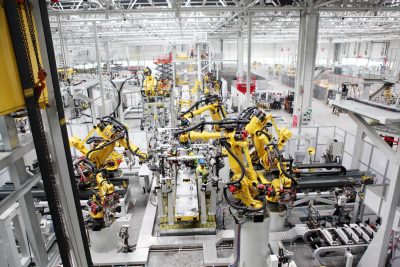China
Financing innovation in China

Author: Xun Wang, Peking University
China’s economic development and financial opening are now at a crucial turning point.
External downside risks now dominate due to the COVID-19 pandemic and trade tensions, and domestic markets urgently need upgrading to lift technological innovation. The recently drafted 14th Five Year Plan emphasises an innovation-oriented development strategy. Although many measures have been adopted, how to effectively finance innovation remains one of China’s primary challenges.
Research and development (R&D) expenditure is a common measure of investment in innovation. Innovation investment is usually long term and tends to run down firms’ internal funds. The availability of external finance is critical for firms trying to innovate.
According to the World Bank, China’s expenditure on R&D as a percentage of GDP experienced steady growth between 1996–2017, rising from 0.56 per cent to 2.12 per cent. Compared to leading industrial countries in 2017, China’s R&D ratio was 0.7 percentage points less than that of the United States and 1.1 percentage points less than that of Japan. More resources have been allocated to capital expenditure over the past few decades.
The key question in coming decades is how China’s financial system can better support innovation investment. Evidence shows that better access to equity market financing leads to substantially higher long-run R&D investment and better innovation performance. Credit market development has a positive impact on fixed investment but zero or negative impact on R&D.
Recent evidence suggests that credit market development has a positive effect on incremental innovation, which are proxied by the count and citation of utility model patents. But it has a negative effect on substantive innovation, proxied by the count and citation of patents of inventions. Equity market development leads to higher substantive innovations but is unimportant for incremental innovations.
China’s financial market is still dominated by the banking sector, especially state-owned banks. The market for direct financing is less developed. The share of bank financing — including bank credit, trust loans, entrusted loans and banker’s acceptances — in the country’s total social financing declined from 87.2 per cent in 2002 to 70 per cent in 2019.
The proportion of direct finance, including corporate bonds and equity financing, in the country’s total social financing increased from 5 per cent in 2002 to 12.3 per cent in 2019. But the role of the stock market has not risen in line with China’s rapid economic growth, probably due to stringent financial regulations. According to PBOC’s statistics, the share of financing through the stock market dropped from 4.6 per cent in 2002 to 2.9 per cent in 2019.
Capital account liberalisation might play an important role in innovation, by facilitating external finance, promoting competition and enhancing corporate governance. Since 2019, China has adopted several measures to ease restrictions on ownership and licenses to foreign financial institutions. This financial opening-up has led to a significant increase in the number of wholly or majority foreign-owned financial institutions operating in China. But these foreign financial institutions still face operational problems such as uncertainty about capital outflow, inflexibility of the renminbi exchange rate and the segmentation of bond markets.
The evidence also shows that the innovation-enhancing effects of capital account liberalisation might be affected by country-specific characteristics such as financial development and institutional quality. This means that countries would have to reach a certain threshold of financial and institutional development before they can expect to benefit from financial openness.
Looking forward, improving access to external finance will play a crucial role in fostering innovation in China.
China should steadily open domestic financial markets more widely to both foreign and domestic private capital. This includes completing interest rate liberalisation, achieving a clean floating exchange rate, facilitating cross-border capital movements and lowering entry barriers for both private and foreign financial institutions.
China also needs to restructure its financial system by enhancing the role of direct financing. It should eliminate restrictions in equity markets and promote the development of multilayered equity markets. Equity markets, including stock markets as well as venture capital and private equity markets,…
Business
China Dismantles Prominent Uyghur Business Landmark in Xinjiang – Shia Waves

The Chinese government demolished the Rebiya Kadeer Trade Center in Xinjiang, affecting Uyghur culture and commerce, prompting criticism from activists amid concerns over cultural erasure and human rights violations.
Demolition of a Cultural Landmark
The Chinese government recently demolished the Rebiya Kadeer Trade Center in Urumqi, Xinjiang, a vital hub for Uyghur culture and commerce, as reported by VOA. This center, once inhabited by more than 800 predominantly Uyghur-owned businesses, has been deserted since 2009. Authorities forcibly ordered local business owners to vacate the premises before proceeding with the demolition, which took place without any public notice.
Condemnation from Activists
Uyghur rights activists have condemned this demolition, perceiving it as part of China’s broader strategy to undermine Uyghur identity and heritage. The event has sparked heightened international concern regarding China’s policies in Xinjiang, which have been characterized by allegations of mass detentions and cultural suppression, prompting claims of crimes against humanity.
Rebiya Kadeer’s Response
Rebiya Kadeer, the center’s namesake and a notable Uyghur rights advocate, criticized the demolition as a deliberate attempt to erase her legacy. Kadeer, who has been living in exile in the U.S. since her release from imprisonment in 2005, continues to advocate for Uyghur rights. She has expressed that her family members have suffered persecution due to her activism, while the Chinese government has yet to comment on the legal ramifications of the demolition.
Source : China Demolishes Uyghur Business Landmark in Xinjiang – Shia Waves
China
China Expands Nationwide Private Pension Scheme After Two-Year Pilot Program

China’s private pension scheme, previously piloted in 36 cities, will roll out nationwide on December 15, 2024, enabling workers to open tax-deferred accounts. The initiative aims to enhance retirement savings, address aging population challenges, and stimulate financial sector growth.
After a two-year pilot program, China has officially expanded its private pension scheme nationwide. Starting December 15, 2024, workers covered by urban employee basic pension insurance or urban-rural resident basic pension insurance across the country can participate in this supplementary pension scheme. This nationwide rollout represents a significant milestone in China’s efforts to build a comprehensive pension system, addressing the challenges of a rapidly aging population.
On December 12, 2024, the Ministry of Human Resources and Social Security, together with four other departments including the Ministry of Finance, the State Taxation Administration, the Financial Regulatory Administration, and the China Securities Regulatory Commission, announced the nationwide implementation of China’s private pension scheme effective December 15, 2024. The initiative extends eligibility to all workers enrolled in urban employee basic pension insurance or urban-rural resident basic pension insurance.
A notable development is the expansion of tax incentives for private pensions, previously limited to pilot cities, to a national scale. Participants can now enjoy these benefits across China, with government agencies collaborating to ensure seamless implementation and to encourage broad participation through these enhanced incentives.
China first introduced its private pension scheme in November 2022 as a pilot program covering 36 cities and regions, including major hubs like Beijing, Shanghai, Guangzhou, Xi’an, and Chengdu. Under the program, individuals were allowed to open tax-deferred private pension accounts, contributing up to RMB 12,000 (approximately $1,654) annually to invest in a range of retirement products such as bank deposits, mutual funds, commercial pension insurance, and wealth management products.
Read more about China’s private pension pilot program launched two years ago: China Officially Launches New Private Pension Scheme – Who Can Take Part?
The nationwide implementation underscores the Chinese government’s commitment to addressing demographic challenges and promoting economic resilience. By providing tax advantages and expanding access, the scheme aims to incentivize long-term savings and foster greater participation in personal retirement planning.
The reform is expected to catalyze growth in China’s financial and insurance sectors while offering individuals a reliable mechanism to enhance their retirement security.
| This article was first published by China Briefing , which is produced by Dezan Shira & Associates. The firm assists foreign investors throughout Asia from offices across the world, including in in China, Hong Kong, Vietnam, Singapore, and India . Readers may write to info@dezshira.com for more support. |
Read the rest of the original article.
China
How a scandal over sanitary pads is shaping feminist activism in China

Chinese sanitary pad brands face scandal over misleading product quality and pH levels. Consumer outrage grows amid larger issues of women’s health neglect and activism for better standards linked to declining fertility rates.
A string of prominent sanitary pad brands in China have become embroiled in a scandal about the quality of their products. The controversy began in early November when consumers complained that that the advertised lengths of many sanitary pads were misleading.
Then, a few days later, customers discovered that many pads had pH levels similar to textiles such as curtains and tablecloths that do not come into frequent contact with skin, potentially causing irritation or harm to users.
The anger only intensified when ABC, one of the companies at the centre of the controversy, responded dismissively to concerned consumers. ABC emphasised that it was complying with national standards, and reportedly replied to a complaint with: “If you cannot accept it, then you can choose not to buy it”.
Chinese companies have since apologised for their sub-par products, and ABC has even said that it was “deeply sorry” for its “inappropriate” response. But for many women in China, this scandal is about more than just defective products. It is part of a troubling pattern in which women’s health and dignity is blatantly disregarded.
In 2022, Chinese women took to social media to advocate for sanitary pads to be sold on trains. Their demands were swiftly dismissed, with China Railway saying sanitary pads were “private items” that women should prepare for themselves in advance.
Some people on the internet echoed this sentiment, arguing that it was inappropriate and unhygienic to sell sanitary pads on trains. “You don’t want sanitary pads sold alongside food, do you?”, one wrote.
Remarks like this laid bare not only the stigma surrounding menstrual blood in China, where it is seen as polluting and shameful, but also the widespread ignorance among men about menstruation. This was again highlighted by one social media user who questioned absurdly: “Why can’t women just hold it in?” The recent scandal over poor quality sanitary pads is yet another chapter in this story.
The neglect of women’s basic needs in China has worsened with the government’s push for higher birth rates. China’s ruling Communist party began actively promoting higher birth rates in the mid-2010s after decades of limiting most families to one child. The push is driven primarily by the state’s concerns over an ageing population and a shrinking labour force.
This pro-natalist agenda, which has been bolstered by media campaigns urging women to prioritise marriage and motherhood, has pressured many to sacrifice their education and careers. In anticipation of having to provide paid maternity leave, employers also often discriminate in the processes of hiring and promotions.
Meanwhile, feminist advocacy faces censorship and suppression. This has included the shutdown of influential media platforms like Feminist Voices and the blocking of #MeToo-related hashtags. Activists have resorted to creative methods, such as using symbols like the “Rice Bunny” (a term that is pronounced “mi tu” in Chinese) emoji, to navigate strict surveillance and content filtering that targets discussions on gender equality.
Why the #RiceBunny hashtag has become China’s #MeToo.
Fighting for change
Women in China are now rallying for higher standards in the production and regulation of sanitary products. They are actively submitting comments via the government’s online platform for the public to provide feedback to standard setting officials.
On November 22, a representative from the organisation responsible for drafting the new standards stated that public feedback had been heard and will be considered in the process. However, this response is far from satisfactory. The same companies that produce sanitary pads in China are heavily involved in setting these standards.
Women’s active involvement in shaping the revision of national standards is reflective of a consistent strategy in which they use government-provided channels for political participation. Yet women in China have now also started to link the issue of low-quality sanitary products to broader societal challenges, including falling fertility rates.
In the 1970s, when China first implemented its one-child policy, over six children were born for every woman of childbearing age. This had dropped to an average of one-and-a-half by the 2000s. At the same time, there is a growing prevalence of infertility in China. A 2021 study published in The Lancet, a peer-reviewed medical journal, shows that China’s infertility rate rose from 12% in 2007 to 18% in 2020. One in every 5.6 Chinese couples of childbearing age faces challenges in conceiving a baby.
Throughout the recent sanitary pad scandal, hashtags such as #LowQualitySanitaryPadsCauseFemaleIntertility have spread across Chinese social media platforms such as Weibo. By aligning their grievances with national anxieties, feminist activists in China are strategically reframing their demands to align with state priorities.
Such an approach may, on the one hand, risk unintentionally reinforcing existing stereotypes about women and societal expectations. But it may also increase the likelihood of their concerns being addressed, as it presents better sanitary product standards as a critical public health and national concern rather than a “women’s issue” that can simply be dismissed.
Feminist activism in China looks to be growing in maturity. Narratives and strategies are now being carefully crafted to ensure maximum impact both in public and policy arenas.
This article is republished from The Conversation under a Creative Commons license. Read the original article.






